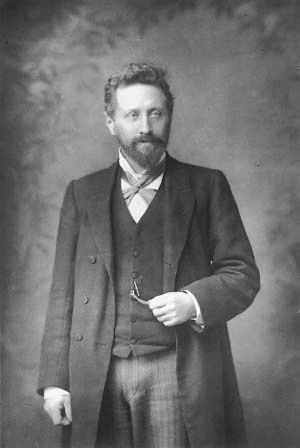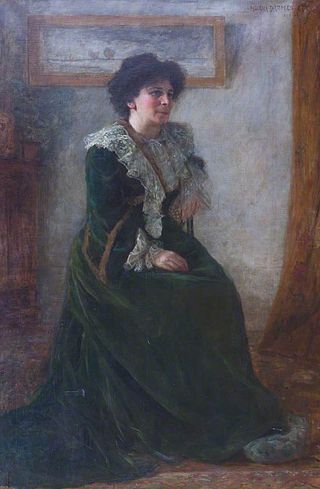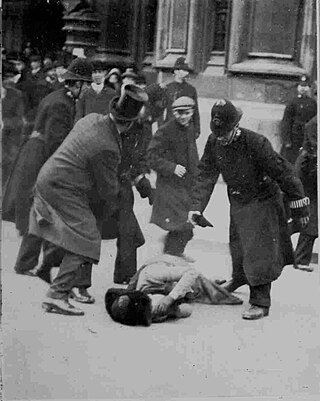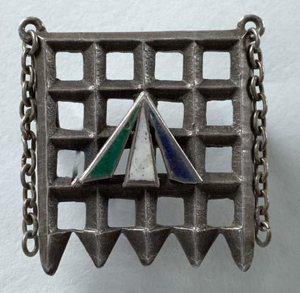
Emmeline Pankhurst was a British political activist who organised the British suffragette movement and helped women win the right to vote. In 1999, Time named her as one of the 100 Most Important People of the 20th Century, stating that "she shaped an idea of objects for our time" and "shook society into a new pattern from which there could be no going back". She was widely criticised for her militant tactics, and historians disagree about their effectiveness, but her work is recognised as a crucial element in achieving women's suffrage in the United Kingdom.

The Women's Social and Political Union (WSPU) was a women-only political movement and leading militant organisation campaigning for women's suffrage in the United Kingdom founded in 1903. Known from 1906 as the suffragettes, its membership and policies were tightly controlled by Emmeline Pankhurst and her daughters Christabel and Sylvia. Sylvia was eventually expelled.

William Edward Ayrton, FRS was an English physicist and electrical engineer.

Phoebe Sarah Hertha Ayrton was a British engineer, mathematician, physicist and inventor, and suffragette. Known in adult life as Hertha Ayrton, born Phoebe Sarah Marks, she was awarded the Hughes Medal by the Royal Society for her work on electric arcs and ripple marks in sand and water.

Black Friday was a suffragette demonstration in London on 18 November 1910, in which 300 women marched to the Houses of Parliament as part of their campaign to secure voting rights for women. The day earned its name from the violence meted out to protesters, some of it sexual, by the Metropolitan Police and male bystanders.

A suffragette was a member of an activist women's organisation in the early 20th century who, under the banner "Votes for Women", fought for the right to vote in public elections in the United Kingdom. The term refers in particular to members of the British Women's Social and Political Union (WSPU), a women-only movement founded in 1903 by Emmeline Pankhurst, which engaged in direct action and civil disobedience. In 1906, a reporter writing in the Daily Mail coined the term suffragette for the WSPU, derived from suffragist, in order to belittle the women advocating women's suffrage. The militants embraced the new name, even adopting it for use as the title of the newspaper published by the WSPU.

Mary Leigh was an English political activist and suffragette.

Mary Jane Clarke was a British suffragette. She died on Christmas Day 1910, two days after being released from prison, where she had been force-fed. She was described in her obituary by Emmeline Pethick-Lawrence as the suffragettes’ first martyr. She was the younger sister of suffragette Emmeline Pankhurst.

Suffrage jewellery refers to jewellery worn by suffragists, including suffragettes, in the years immediately preceding the First World War, ranging from the homemade to the mass-produced to fine, one-off Arts and Crafts pieces. Its primary purpose was to demonstrate its wearer's allegiance to the cause of women's suffrage in the UK. Jewellery was a key mechanism used by British suffragists to identify themselves.

Georgina "Ina" Agnes Brackenbury was a British painter who was known as a militant suffragette. She was jailed for demonstrating for women's rights. She followed Emmeline Pankhurst's lead as she became more militant. Brackenbury was one of Emmeline Pankhurst's pallbearers. Her portrait of Pankhurst was bought by her memorial committee for the nation.

Marie Venetia Caroline Brackenbury (1866–1950) was a British painter who was a militant suffragette and suffragette artist. She was jailed for demonstrating for women's rights. She followed Emmeline Pankhurst's lead as she became more militant. Her home was known as "Mouse Castle" because it looked after recovering hunger strikers. The house now has a plaque which remembers the trio of her sister, her mother and Maria. She was the younger sister of Georgina Brackenbury, also a painter and militant suffragette.
Lettice Annie Floyd was a British suffragette. She is especially known for her openly lesbian relationship with fellow suffragette Annie Williams. During the suffragette campaign, Floyd and Williams were arrested and force-fed. After World War I, Floyd continued to campaign for women's rights and peace.

Florence Eliza Haig (1856–1952) was a Scottish artist and suffragette who was decorated for imprisonments and hunger strikes.

Ada Cecile Granville Wright was an English suffragette. Her photo on the front page of the Daily Mirror on 19 November became an iconic image of the suffrage movement.

Lucy Minnie Baldock was a British suffragette. Along with Annie Kenney, she co-founded the first branch in London of the Women's Social and Political Union.

Gladice Georgina Keevil was a British suffragette who served as head of the Midlands office of the Women's Social and Political Union between 1908 and 1910.

Ada Susan Flatman (1876–1952) was a British suffragette who worked in the United Kingdom and the United States.

Edith Hudson was a British nurse and suffragette. She was an active member of the Edinburgh branch of the Women's Social and Political Union (WSPU) and was arrested several times for her part in their protests in Scotland and London. She engaged in hunger strikes while in prison and was forcibly fed. She was released after the last of these strikes under the so-called Cat and Mouse Act. Hudson was awarded a Hunger Strike Medal 'for Valour' by the WSPU.

Louise Mary Eates was a British suffragette, chair of Kensington Women's Social and Political Union and a women's education activist.

The Holloway brooch was presented by the Women's Social and Political Union (WPSU) to women who had been imprisoned at Holloway Prison for militant suffragette activity. It is also referred to as the "Portcullis badge", the "Holloway Prison brooch" and the "Victoria Cross of the Union".




















